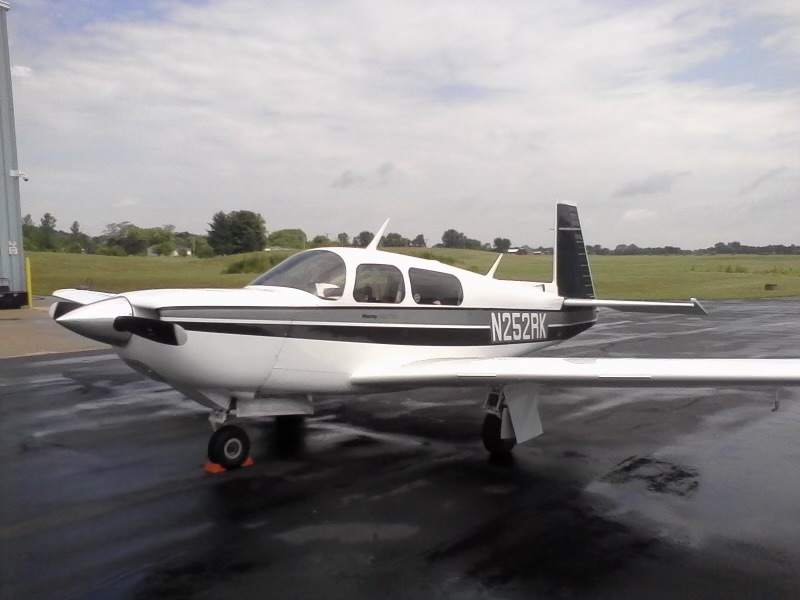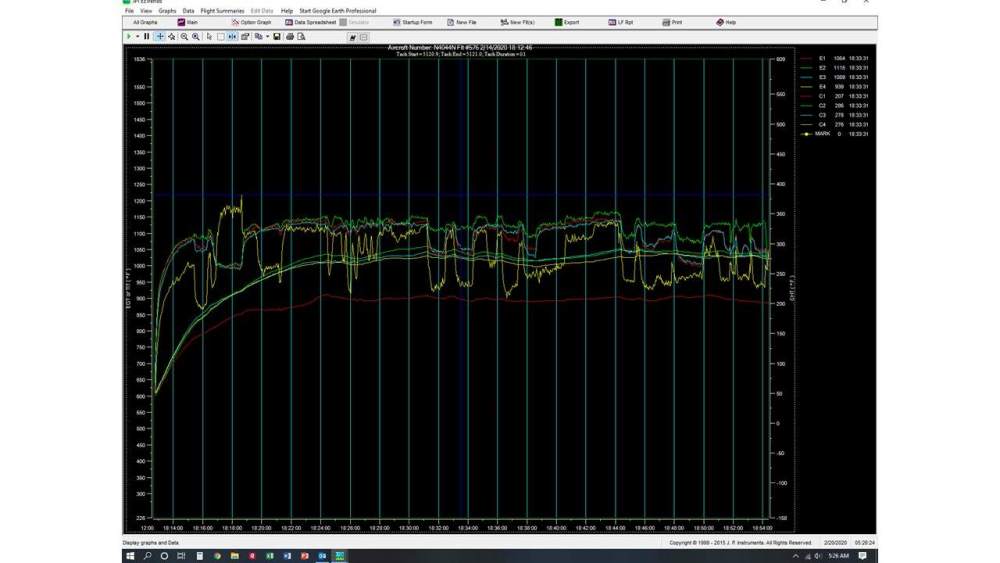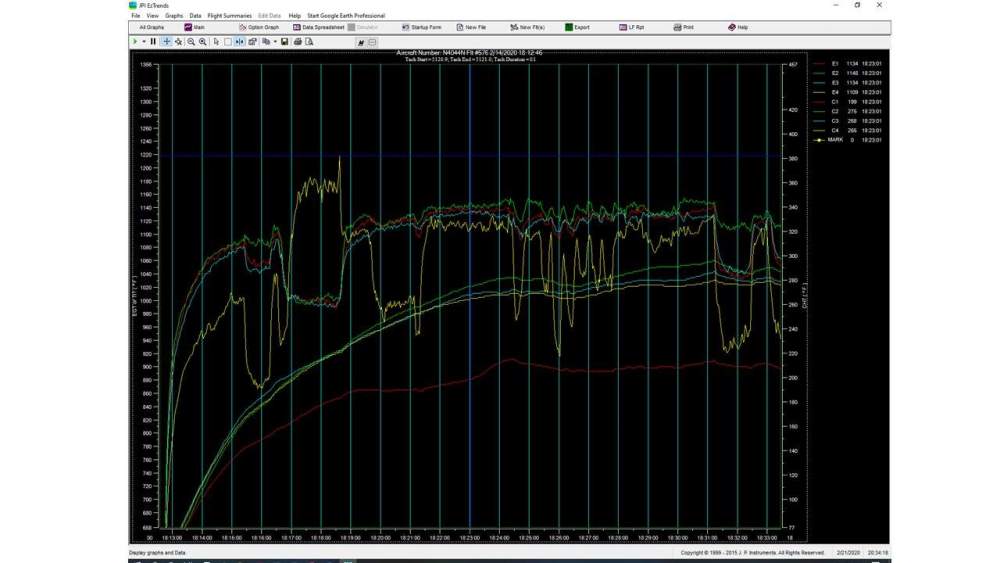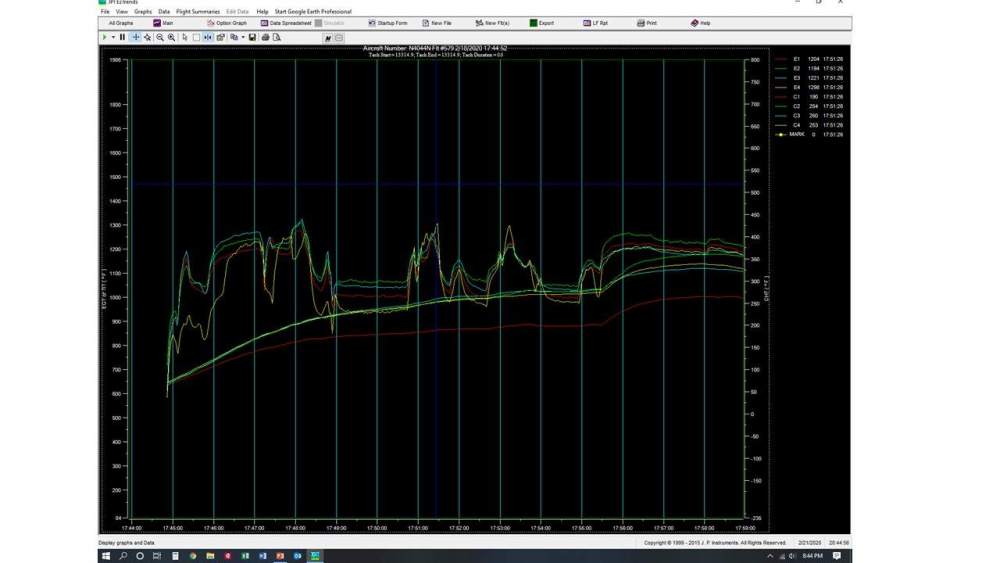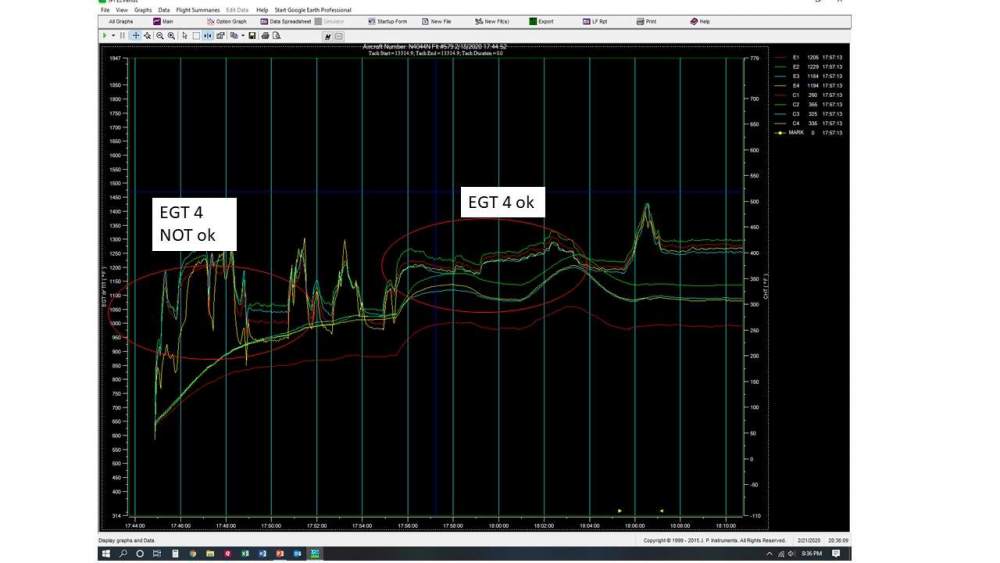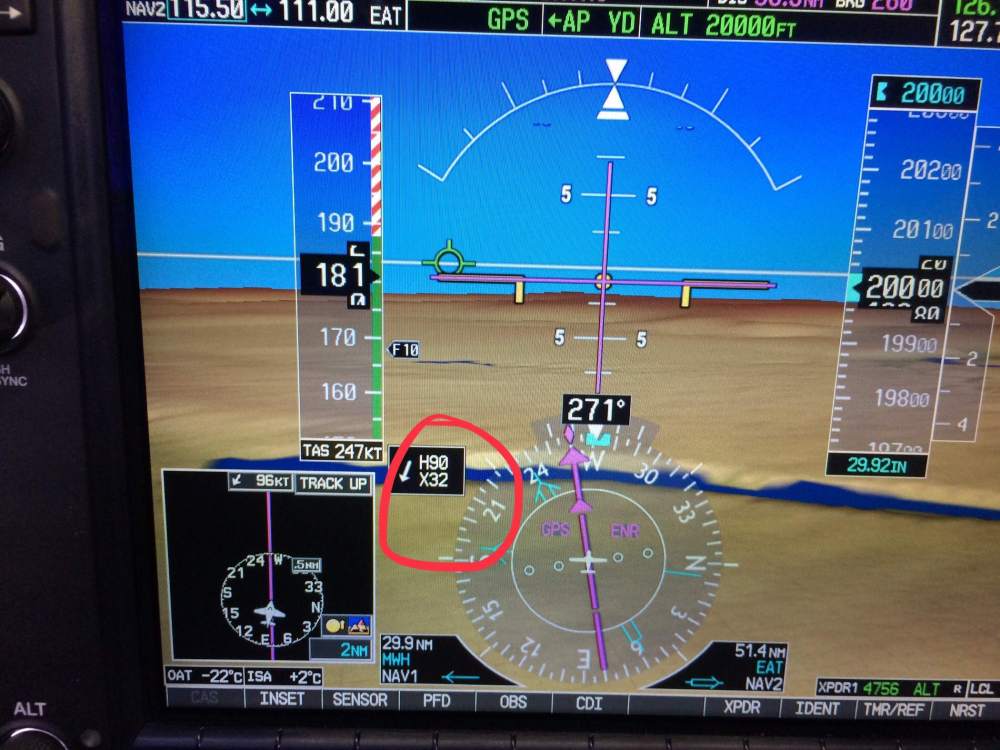-
Posts
5,469 -
Joined
-
Last visited
-
Days Won
25
Content Type
Profiles
Forums
Blogs
Gallery
Downloads
Media Demo
Events
Everything posted by Ragsf15e
-
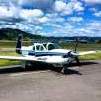
Help Diagnosing Rough idle / cool/erratic egt
Ragsf15e replied to Ragsf15e's topic in General Mooney Talk
That’s what I keep leaning towards. I’m gonna take a look at it this weekend and then check more thoroughly for leaks with my mechanic on Monday. Probably swap the probe too just to be sure. -

Help Diagnosing Rough idle / cool/erratic egt
Ragsf15e replied to Ragsf15e's topic in General Mooney Talk
I’ll see if I can upload and share it from saavy. The Gami spread has been consistently 0.4 for the last couple flights, so not bad, and the engine runs smoothly LOP. I have Gami injectors and Tempest fine wires. The injectors are in the correct locations and the spark plugs tested ok at the annual last month. They looked ok when we pulled them yesterday. It just seems like the lower power (taxi and ground time) is where it’s erratic. -

Help Diagnosing Rough idle / cool/erratic egt
Ragsf15e replied to Ragsf15e's topic in General Mooney Talk
I did do that on the last flight. I did it LOP per the Savvy guidance and it was fine. The ignition doesn’t seem to be the problem. I’m open to any possibilities, but if it was a spark issue, I think the egt would be hotter. Right now I’m starting to think probe issue, or intake / exhaust leak? Maybe the roughness was my imagination staring at faulty egt data? *btw, if you do an in flight mag check with a Surefly, even a new one with the new “quicker start up”, maybe you should reduce power before going from Surefly off, through mag off, back to both. Loud pop that will get your attention. At 1700rpm during the normal ground mag check, it’s just a quiet skip. At 2500rpm it’s more exciting. -
My F model just came out of annual. I have a new cylinder (#2), Surefly mag and a newly IRAN right mag. The only cylinder that’s not been recently overhauled is #4. It was running fine coming into annual, but my IA noted some oil in the bottom and some deposits on the exhaust valve and stem. Compression was fine. So I flew the plane 3 times to break in #2 and I’ve noticed slightly rough idle. I was thinking “morning sickness” but then I noticed #4 egt. It’s really low at low power. It’s also erratic. It seems to clean up for the mag check and during flight, but comes back at low power. Today we borescoped #4, looks ok, same deposits but valves open and close fine. Compression check was just fine. Plugs look good. IA took rocker box cover off and springs were ok, valve didn’t seem to “wiggle”. What am I looking at? Failed egt probe? Maybe exhaust or induction leak to #4? I looked at jpi data from a couple months ago and it was fine. This one was only on the ground, but is a good example. RPM between 1000 and 1600. This is startup. Mag check and takeoff. Egt is erratic at low power.
-
Not at my airport. 100LL is $6.00/ gallon!! $5.75 if you self serve it. Luckily, KSFF is pretty close to a bunch of Idaho airports with reasonable prices and good restaurants. I almost never buy gas at home. 64 gallon tanks are awesome!
-

IFD 440 vs GNS 430W with 210 Flightstream
Ragsf15e replied to John Mininger's topic in Avionics/Panel Discussion
Awesome, I was hoping that’s what you meant! I totally agree the more intuitive designs are better, but sometimes it takes a while to get there even if the underlying capability is there. The 430W is a very capable navigator but it was developed while you were an infant and released when you were 5. It is what it is. If I have my choice, the more intuitive (IFD or GTN) would be great but, like you, I’m still gonna read the manual. A lot of times it’s just how well a certain design philosophy meshes with the way we think. I fly a G1000 airplane for work, and I’ve been super confused each time I flew in a Honeywell FMS equipped jet with similar capability - even with practice and study. iPhone vs Android. -

Help, I think I broke my airplane
Ragsf15e replied to Ragsf15e's topic in Vintage Mooneys (pre-J models)
So you guys were right, no damage except to my ego. Small scratch on both gear doors where they pressed against the cowl flaps. Ugh, why do I have to keep learning lessons that I already should know? -

IFD 440 vs GNS 430W with 210 Flightstream
Ragsf15e replied to John Mininger's topic in Avionics/Panel Discussion
Hah! That made me laugh... “It almost requires that you read the manual before even attempting to use it.” Dang whippersnappers (said tongue in cheek and with a smile)!! Ok, maybe I’m a crabby old ATP/CFI/CFII/Fighter Pilot, but yes, you should definitely read the manual before attempting to use aviation technology. That includes whatever documentation there is for the airplane, avionics, propellor, regulations, etc. Are you gonna memorize it? No. But read it? Yes. I realize your phone and car aren’t designed like that, but they are designed for the lowest common denominator and you’re a pilot, you aren’t the lowest common denominator anymore. Hopefully you’re a professional pilot regardless of what type of licenses or ratings you have. So yes, by all means, read the manual, practice using the 430 on the sim Garmin provides, practice in the airplane. Do not expect to sit down in a general aviation airplane and magically know how everything will operate. You will quickly find out how your assumptions and lack of knowledge get you into trouble or hurt someone. Rant over. And I really mean no offense. -

Help, I think I broke my airplane
Ragsf15e replied to Ragsf15e's topic in Vintage Mooneys (pre-J models)
Thanks, I sure hope you’re right about learning something... and it would be nice if there’s no damage, but I still feel terrible about it. -

Help, I think I broke my airplane
Ragsf15e replied to Ragsf15e's topic in Vintage Mooneys (pre-J models)
I didn’t hear anything abnormal but that could be my Bose anr working. I did do a few speed runs at different altitudes and power settings as I was breaking in the cylinder and I was wondering why I was about 3kts slower than before the annual. I’m pretty sure I now know why. -
Ok, from the beginning, this is my fault as the PIC... I did the walk around. My F Just came out of annual. Lots of stuff done... Surefly, other mag IRAN, new overhauled cylinder, G5s x 2, etc. So I go pick up the airplane to do the ground engine run as called for by lycoming and then fly it to start breaking it in. My mechanic is there, releases it to me, we both go through the engine carefully after the ground engine run and then I go fly it. 2.5 hours. High power 75%+ as called for in the break in instructions. Fast. After retuning mechanic looks it over carefully again for leaks. Here comes the good part... Next time I go flying, it’s breezy and I notice both nose gear doors flapping in the breeze. They are disconnected, bolts are in the rod ends with nuts on them but not connected. Holy $&%#! They were never reconnected after the annual. So other than a scratch where it looks like the doors rubbed against the cowl flap next to it, where else should I be looking for damage? The piano hinge has some play but I think it was similar before? I plan to be with my mechanic as we jack up the airplane and swing the gear next week. Its a sick feeling in my stomach as I think I could have jammed the doors in the nose gear somehow but instead I got lucky.
-
I’m just on the other side of the state from you. Job #1 for you might be finding an available and affordable hangar. It’s a difficult task depending on what airport you plan to use. Especially in a wet/salty climate, a hangar is the best option for the airplane to stay in good shape.
-
Here’s the deal... the C, E and Fs are ~50+ years old. They definitely won’t be perfect. Even well cared for examples will need things fixed. If there’s a prebuy and nothing is found, it wasn’t a good inspection. Have an MSC or experienced Mooney mechanic look it over carefully for show stoppers like spar corrosion or maybe an engine that’s toast. Pucks and fuel tanks can be repaired with money, so that’s just a question of purchase price and your own plans. They will almost all have some issues with plastics and or paint. On the plus side, they aren’t that hard to work on, efficient, fast, and they are yours.
-

CHTs average difference between 1 and 3
Ragsf15e replied to JimB's topic in Vintage Mooneys (pre-J models)
I didn’t know about either of the mods to #1 or #2, thanks. Is there a reason to want them closer together or is it fine as long as they are all 275-350 ish? -
I was hoping to avoid taking off the plastic emer gear cover before being prepared to fix the CB, but that might have to happen. I did my parts manual research and found the number but that doesn’t seem to exist. I did find an old thread where @Marauder said he replaced his and was hoping he or @M20Doc might just know it. Alright, I’ll get some pictures.
-

CHTs average difference between 1 and 3
Ragsf15e replied to JimB's topic in Vintage Mooneys (pre-J models)
I have a 68F and it’s similar. Mine might have a bigger spread actually. At one point I had my cht probes swapped to see if that changed it but it didn’t. #1 gets real good airflow, #3 doesn’t. Weird thing for me is that #2 is pretty close to same temp as 3, yet it’s in the front like much cooler 1. The airflow is crazy in there. I have a lasar cowl closure which may or may not make a difference. -
So I popped the small “gear control circuit breaker” on the pilot sidewall near the manual extension crank. Resetting it, I realize it’s done. It’s not a positive click to reset, kinda sloppy and definitely old. Thankfully, reset worked because I was airborne. I looked in the parts manual to find the correct part for that and the 25amp gear motor CB right next to it and I get D7071-8-25 and Dsm-5n. Only I can’t find that part number to buy anywhere. Anyone know what current part number I’m looking for? thanks!
-
Snubber. Thats a relatively common issue. Something like a “water hammer”. Pressure fluctuations at the electric pressure sensor. Mine does the same. It was worse, maybe a 1.0 fluctuation. I just had it updated and the firmware helps. Now it is about 0.5. Supposedly you can call jpi and they have some kind of a “snubber” that attaches before the sensor and fixes the problem.
-
Oh that’s awesome, thanks. I’m definitely going that route when the current “weather strip” solution is destroyed. By being on the airplane side, it gets pulled apart by the slide on the bottom of the door each time you close it. So trimming around the latches didn’t cause the seal to come apart there I guess?
-
My 930 has been flawless for 6 years and 600 hours. It’s a pain to send it in for firmware or tach times, etc, but the unit has been great. However, I’ve now hosed myself as I just got it back from firmware update and am about to fly it first time. It better not have to go back for 2 weeks!
-
That’s how they got it over the hump from 200mph to 201mph!
-
I guess, but I think if the winds are strong enough to rip out the tie down, they’re going to do significant damage to the airplane tossing it around when it’s unsecured anyway. Ropes should be tight enough that a forgotten tie down makes taxi at/near 1000rpm is impossible. When full power is required for taxi, shut down and remove chocks and/or tie downs.
-
Maybe closer to our Acclaim performance and concerns... higher and the headwinds got much stronger. Lower and the icing got much worse (FL200 was -22c). Foreflight had the average headwinds at 62kts. I never saw less than 80kts above 10,000’. Fuel and alternate fuel become a concern. Ive noticed Foreflight has a tendency to underestimate headwinds.
-

M20E - OFFICIAL FOREFLIGHT PERFORMANCE PROFILE
Ragsf15e replied to bill98's topic in Vintage Mooneys (pre-J models)
The foreflight performance level subscriptions have a much more detailed profile that you can’t just enter into the basic subscriptions. The basic ones are fine for a non turbo Mooney. Check the other active thread for a place to start. -

Mooney M20E Super 21 FF Performance Profile
Ragsf15e replied to dgbecht's topic in Vintage Mooneys (pre-J models)
Generally you can start with something relatively simple and fine tune altitudes and rich of peak vs lean of peak. I probably have 8 profiles but usually only use one or two. Try this for cruise at ~8,000-10,000 rich of peak. climb (it’s an average from takeoff to cruise altitude) 500fpm, 110ktas, 15gph Cruise 145ktas, 11 gph Descent 500fpm, 11gph, 165ktas Assumes descent at cruise power. Also, I know you climb faster initially, but that’s an average at mgw up to 10,000’ Refine from here...

